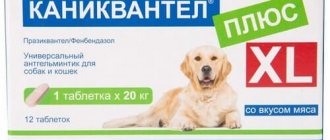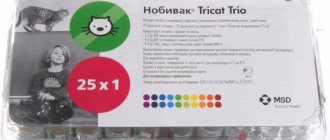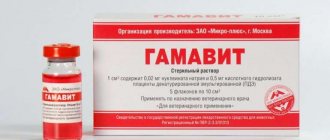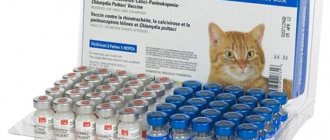| Description of the drug | |
| Release form and storage conditions: | Vaccines in the form of a dry part (white or pinkish powder) and a liquid solvent (clear liquid), are packaged in glass ampoules; Shelf life of the powder is 24 months at a temperature of 2-8°C, shelf life of the solvent is 60 months at 2-25°C |
| Price: | 70-750 rubles per 1 dose (1 ml bottle) depending on the type of vaccine |
| Analogues: | Multikan, Geksakanivac, Dipentovak |
What is Nobivak for dogs?
Comprehensive vaccination is a mandatory annual event for dogs and cats. The procedure is the best prevention against the most dangerous animal diseases of an infectious nature. In addition, leptospirosis and rabies pose a direct threat to humans.
Nobivak is a company that produces high-quality vaccines for dogs and cats. The company's employees are constantly developing more and more new drugs that protect pets from infectious pathologies. Nobivak is widely distributed throughout the world and is in great demand among veterinarians and animal breeders.
It is worth noting that no vaccine provides a complete guarantee that a pet will not become infected with the virus after vaccination. In addition, microorganisms mutate over the years, and new species appear that infect animals and cause serious health problems. However, in vaccinated animals the disease is mild and they have a greater chance of survival.
Correct storage conditions
Proper storage of vaccines ensures their safety and effectiveness. Almost all Nobivak vaccines are available in two bottles:
- Dry powder – vaccine.
- The liquid is a solvent.
If the packaging is unopened, the shelf life is as follows:
- Vaccine – 24 months.
- Solvent – 60 months.
While the vaccine is being stored or transported, it should be protected from direct sunlight and overheating. Permissible storage temperature range:
- Powder: 2–8 degrees.
- Solvent: 2–25 degrees.
Important! After opening, subject to temperature conditions, the vaccine is stored for up to 24 hours, after dissolving the powder for up to 4 hours.
Description
Vaccine for dogs (nasal drops) against bordetellosis and parainfluenza 1 dose + diluent.
The live dry vaccine against bordetellosis and canine parainfluenza in one dose contains at least 108 CFU of the attenuated pathogen Bordetella bronchiseptica strain B-C2 and 103 TCD50 of the causative agent of carnivorous parainfluenza strain Cornell, as well as stabilizers: hydrolyzed gelatin, pancreatic hydrolyzate of casein and sorbitol. A special solvent for vaccines, Nobivac Diluent, is a transparent sterile phosphate buffer with a pH of 7.2 - 7.4. In appearance, the vaccine is a homogeneous porous white mass. Nobivak KS is packaged in 1 dose, solvent - 0.4 ml in glass vials, hermetically sealed with polymer caps, rolled with aluminum caps and packaged in 1, 5 or 25 doses with the corresponding number of Nobivak Diluent bottles in a cardboard box with cells.
Compound
The drug is a combined live vaccine for dogs against canine distemper, parvovirus infection and infectious hepatitis. It is a white lyophilisate. The solvent used is a phosphate buffered solution for injection or a liquid vaccine such as Nobivak RL, Rabies or Lepto. A bottle of the drug, that is, one dose, contains: canine parvovirus (strain 154) - at least 10 million TCD/50, canine distemper virus (Onderslepoort strain) at least 10 thousand TCD/50, adenovirus (strain Manhattan LPV3 serotype 2) 10 thousand PFU.
Release form, composition and packaging
International nonproprietary or chemical name: Animal rabies vaccine, inactivated
Developer: “Intervet International BV”, Wim de Korverstraat 35 PO Box 31 5830 AA Boxmeer, The Netherlands
Manufacturer: “Intervet International BV”, Wim de Korverstraat 35 PO Box 31 5830 AA Boxmeer, The Netherlands
Dosage form: suspension for injection
Qualitative composition and quantitative composition of active ingredients and qualitative composition of excipients: The vaccine contains the cultural liquid of a continuous cell line (BNK-21 clone CT), infected with a fixed rabies virus (strain “Pasteur RIV”), inactivated 6-propiolactone, adjuvant - phosphate aluminum and a buffer component - glycine.
Quantity in consumer packaging: 1 ml (1 dose) in bottles
Types of vaccine
Several types of vaccines are produced under the trade name nobivac:
Nobivac Lepto
Intended for vaccination of dogs against leptospirosis. The first vaccination is given when the puppy is two months old, followed by a booster vaccination two weeks later. Next, you need to vaccinate your dog every year. Immunity to the disease occurs three weeks after vaccination and is active for a year.
Nobivac Rabies
Designed for vaccinating pets against rabies. Puppies are given their first vaccination at the age of three months, then annually. Immunity begins to develop three weeks after administration and protects the dog from the virus for three years.
Nobivak RL
Designed for vaccinating dogs against leptospirosis and rabies. Recommended as a revaccination against leptospirosis and vaccination/booster vaccination against rabies. Primary administration is carried out at the age of three months, then annually.
Nobivac L4
Designed for vaccinating dogs against leptospirosis. A more modern and advanced drug than nobivac Lepto. Puppies are given their first vaccination at the age of 6 weeks, then revaccinated at 10 weeks. Subsequent vaccinations are given annually.
Nobivac PuppyDP
Designed for vaccinating pets against parvovirus enteritis and canine distemper. The first vaccination is given to puppies at the age of 1 month, then annually.
Intended for vaccinating dogs against infectious hepatitis, parvovirus enteritis, and canine distemper. The first vaccination is given at the age of 2 months, then once every three years.
Intended for vaccinating dogs against infectious hepatitis, parvovirus enteritis, and canine distemper. The first vaccination is given at the age of 2 months, then once every three years.
Nobivac DHP
Intended for vaccinating dogs against infectious hepatitis, parvovirus enteritis, and canine distemper. The first vaccination is given at the age of 2 months, then once every three years.
Nobivak dhppi
Intended for vaccinating pets against canine distemper, infectious hepatitis, parainfluenza, parvovirus enteritis. The first vaccination is given at the age of 2 months, the second a month later, then once annually.
Nobivak KS
Designed for vaccinating animals against bordetellosis and parainfluenza. It is administered as drops into the nose. The first vaccine is used at the age of 2 weeks, the second one a year later.
Reviews
Lisa: “Last year I vaccinated my two dogs with Nobivac. First complex, then from rabies. The pets tolerated all the injections normally, with no side effects, loss of appetite or well-being. The drug worked with a bang: the neighbor’s dog, with whom mine constantly communicate, fell ill with distemper, but this dirty trick bypassed us.”
Anna: “I have a very timid dog, he hates injections, and constantly throws tantrums. But he tolerates Nobivac injections calmly. After the vaccination, his health does not change: no drowsiness, he eats and plays as always. Excellent inexpensive product."
Nadezhda: “I’ve been vaccinating my dog with Nobivak for four years now. It’s a high-quality drug, the dog always tolerates it well, our vet uses only this vaccine.”
Olga: “I have extensive experience in keeping animals - from dogs to ferrets. I always vaccinated everyone with Nobivak. Now there are two huskies living in the house: workers, for hunting. The eldest dog is already 11 years old. And during all this time I have never fallen ill with infectious diseases, and always tolerate vaccination well.”
Igor: “A good friend’s dog died after being injected with Nobivac. Half an hour later, a terrible allergy appeared, the puppy was swollen to the point of a balloon. We turned around halfway home and back to the clinic, but we couldn’t save the animal.”
Lily: “I have a Yorkie puppy. We did the first vaccinations ourselves, because... We were given a kitten that was not vaccinated. I was terribly worried, carefully chose the drug and settled on Nobivak. The baby tolerated both vaccinations well: he slept a lot, tried to reach the injection site (apparently it was itching), but he ate well.”
How the vaccine works
To fight an infection, the body produces antibodies specific to a particular pathogen. It takes several days for the immune system to create them. When a second “meeting” with this infectious agent occurs, the immune system no longer wastes time identifying the pathogen, but starts the production of antibodies immediately, preventing the multiplication of the immunogen.
An inactivated vaccine is a preparation containing neutralized, non-viable viruses. They are not able to cause disease, but provoke the body to create means of defense against it. As a result of the Nobivak Rabies vaccine, the cat produces specific antibodies against the rabies virus, and if the animal comes into contact with the virus carrier, the body successfully copes with them, preventing the development of the disease.
Safety and personal hygiene
Female puppies are given injections even during pregnancy. Before using the vaccine, you need to shake the tube it is inside. If the container with the drug has been damaged, or the vaccine itself has deteriorated, the hitherto unused substance can be disinfected by boiling the liquid for ten minutes, and then disposed of.
Vaccination should be done using a sterile syringe , and the place where you plan to give the injection should be treated with an alcohol solution. The doctor or person who performs the procedure must wear special clothing. Personal protective equipment must be present near him. Also put a first aid kit next to you, with which you can provide first aid if necessary.
If the vaccine suddenly gets on the body or mucous membrane, rinse the area with plenty of water. If you have injected yourself or another person with this drug, go to hospital immediately.
Composition and description of the vaccine Nobivak Rabies
The rabies vaccine nobivac rabies is a suspension that contains inactivated, already killed virus rabies - rabies viruses.
In order for the body to intensively develop immunity to the substance, the vaccine contains an adjuvant.
It also includes some substances that help the body respond correctly to the injected serum.
Nobivac Rabies is made only from killed viruses. This eliminates even the slightest risk of infection with a weakened but live rabies virus. 1 package contains 10 bottles.
The appearance of the drug is a suspension, colored yellow or pink, of varying saturation. Supplied in transparent, glass bottles of 1 ml. The bottles are closed with rubber plugs and secured with aluminum tape.
Supplied in clear, glass bottles of 1 ml
How to vaccinate yourself
It is better to give the first vaccinations to a veterinarian, then you can give the injections yourself, following the instructions for the drug. It is important to remember that you cannot vaccinate an animal that is weakened by illness or is sick; the veterinarian will be able to determine the malaise. Before administering the vaccine, it is necessary to carry out deworming. If the owner does not observe changes in the dog’s behavior, then the procedure can be carried out. There is the following sequence of actions:
- Open the bottle of dry vaccine (it should be diluted with 1 ml of Diluent solvent), shake the finished mixture before use. Nobivac Lepto and L4 are sold ready-made and can be directly drawn into a syringe.
- Prepare the skin on the withers for injection: clean the area from dirt to avoid infection, make sure there are no wounds.
- Immobilize the dog's head so that it does not jerk during the injection.
- Vaccines are administered under the skin (2-3 mm), it is important to remember that the injections are not intramuscular.
- After injecting the drug, remove the needle and treat the area with an antiseptic.
The intranasal vaccine Nobivac KS is easier to use. The instructions for use of the drug suggest starting prophylaxis from the age of two weeks. The Nobivak intranasal vaccination for puppies is injected into the nostril. To vaccinate, shake the bottle, draw the contents into a sterile syringe, then use a special nozzle to inject the drug into the nose.
Rules of application
Vaccination with the Nobivak Rabies vaccine is allowed for cats from the age of 3 months, provided that they are healthy. Unlike the Nobivac triquet trio vaccine, pregnancy is not a contraindication to the use of Nobivac Rabies. If, due to an unfavorable epizootic situation, such a vaccination was done earlier, it must be repeated when the animal reaches the age of 3 months. Scheduled revaccination is carried out once every 3 years.
About two weeks before your cat is scheduled to be vaccinated against rabies, be sure to deworm your pet. The helminthic infestation present in the animal’s body greatly reduces the effect of the vaccine and prevents the formation of active immunity.
The Nobivac Rabies vaccine is administered intramuscularly or subcutaneously. The procedure is carried out as follows:
- The bottle with the drug is shaken vigorously until a homogeneous emulsion is obtained.
- Having bent the center of the aluminum cap, wipe the rubber stopper with alcohol.
- Having pierced the stopper of the bottle with a needle, transfer its contents into a syringe.
- The injection site is treated with alcohol.
- After removing the air from the syringe, the drug is injected into a retracted skin fold on the neck or a muscle located under the knee.
- The cat is kept under observation for 10-15 minutes.
The rabies vaccine Nobivak Rabies can be used by mixing it in a syringe in a 1:1 ratio with the leptospirosis vaccine Nobivak Lepto. The use of Nobivac Rabies with the Nobivac Tricat trio vaccine against viral rhinotracheitis, calicivirosis and panleukopenia is permitted provided that they are administered with different syringes.
Vaccination scheme
The Nobivak vaccination regimen is compiled individually for each dog. But there is a general vaccination schedule recommended by the manufacturer .
| Vaccine | Age of first vaccination | Revaccination | Combination with other serums |
| DHPPi | At 8 weeks. | 12 weeks, then annually. | R.L., Rabies, Lepto. |
| DHP | At 8-9 weeks. | At 3 months, then every year. | R.L., Rabies, Lerto. |
| Rabies | At 3 months. | Once every 3 years or every 12 months. | DHPPi, DHP, Lepto. |
| Puppy DP | At 6 weeks, in a difficult epizootic situation at 1 month. | At 8-9 weeks with DHPPi or DHP. | – |
| R.L. | From 8-9 months. | After 2-3 weeks with Nobivak Lepto. Then every year. | DHPPi, DHP. |
| KC | From 2 weeks. | Annually. | – |
| Lepto | From 2 months. | At 10-11 weeks. Subsequently, annual double vaccination with an interval of 14-21 days. | DHPPi, DHP, Rabies. |
| L4 | At 6-8 weeks. | After 2-4 weeks, then annually. | DHPPi, DHP, Puppy DP, combination with other Nobivac drugs is allowed, but without mixing in one syringe. |
A separate vaccination scheme for puppies with Nobivak is worth mentioning. It is not necessary to vaccinate with Pappy DP: it is used only in severe epizootic situations in the area, if there are many dogs in the kennel or the owner is constantly in contact with disadvantaged animals: stray, sick, in a shelter, etc. In other cases, the first scheduled vaccination at 8-9 is sufficient weeks using DHPPi or DHP.
Instructions for use and dosage
It is recommended to vaccinate cats and dogs (as well as ferrets, foxes, raccoons, minks) from 3 months. The vaccine is administered subcutaneously or intramuscularly in an amount of 1 ml, which is 1 dose.
If for some reason the animal was vaccinated earlier, it is necessary to vaccinate the animal again at this age. Livestock (sheep, goats, horses, cattle) are vaccinated from 6 months.
1 dose of vaccine (1 ml) is administered intramuscularly.
If the animal was vaccinated before 6 months, then it is vaccinated again at 6 months of age.
Vaccination can only be given to healthy animals. Pregnant females can also be vaccinated with this vaccine. They are vaccinated intramuscularly.
If the owner wishes to vaccinate the animal himself, he must remember that:
- 10 days before vaccination (at least), the pet must be treated against parasites;
- after vaccination, do not wash for at least 10 days;
- in the coming days after vaccination (two weeks) do not change your diet;
- during the first vaccination, do not allow contact with other animals for 2 weeks (the entire quarantine period);
- You should take special care of your pet for 2 weeks - do not overload, do not tire, do not overcool.
During the first 3 days after vaccination, you should especially carefully monitor your pet's condition.
Before vaccination, the vaccine bottle must be warmed to the pet’s body temperature. This can be done under running hot water.
After the bottle is opened, it is administered immediately. The syringe used is only sterile. Disposable. After injection, the vial and syringe should be burned.
The injection site is not wiped with anything, so as not to disrupt the proper action of all strains of the vaccine.
Before vaccination, the vaccine bottle must be warmed to the pet’s body temperature.
Vaccination for puppies "Nobivak" at the Biryulevsky Veterinary Center
Specialists at the Biryulevsky Veterinary Center strongly recommend vaccinating puppies with Nobivac, which has proven itself to be a reliable remedy against some fatal infectious diseases. The clinic’s veterinarians note several features of vaccination with the drug:
- Only absolutely healthy animals are allowed to be vaccinated. Before administering the injection, an examination by a physician is required.
- Revaccination should be carried out once a year by administering one dose of the drug. After the injection, antibodies begin to be produced in the dog's blood.
- Vaccination of puppies with Nobivak is carried out under the skin near the shoulder blade or in the neck area.
- The clinic’s specialists do not vaccinate dogs “Nobivak” 14 days before the female gives birth and for 21 days after it, for unhealthy animals, as well as in the first 7 days after deworming.
- At the Biryulevsky Veterinary Center, all conditions for storing and transporting the vaccine are observed. The drug is administered according to the instructions.
- 1 dose of Nobivac is given to one animal, regardless of age and weight.
Proposed vaccination schedule Nobivak RL
Depending on the local situation and the maternal immunity status of the animal, a choice may be made from the following vaccination programs:
- No direct risk of infection: 9 weeks of age Nobivac® Lepto and Nobivac® DHPPi. 12 weeks of age Nobivac® DHPPi and Nobivac® RL. In healthy dogs, this program will provide complete protection from all included components.
- Risk of parvovirus infection in weaned puppies. 9 weeks old Nobivac® DHPPi and Nobivac® Lepto. 12 weeks of age Nobivac® DHPPi and Nobivac® RL. The first vaccination after 9 weeks will protect 90% of puppies from parvovirus disease. The second vaccination will provide complete protection against all included components.
- Risk of parvovirus and plague infection. Age 6 weeks Nobivac® Puppy DP. 9 weeks old Nobivac® DHPPi and Nobivac® Lepto. 12 weeks old Nobivac® DHPPi and Nobivac® RL. The first vaccination after 6 weeks will provide protection against parvovirus disease in 75% of puppies, the second vaccination will increase this percentage to 95%, and the third vaccination will provide complete protection against all components.
Vaccines and the cold chain: maintaining the cold chain
The Infectious Disease Bulletin focuses on factors influencing the quality of the Dutch national vaccination program [ 1 ]. The conditions for transporting the vaccine from the manufacturer to the final consumer are very important. This path is usually called the “cold chain”. If the chain is too “weak,” it may break, rendering the vaccine ineffective. The World Health Organization's extensive Immunization Program has for many years focused on maintaining the cold chain, mainly in tropical and subtropical countries. Thus, in Nigeria, differences in seroconversion rates after measles vaccination at two vaccination centers in Nigeria were found to be largely due to vaccine handling [2]. In the 80s, this type of research began to be carried out in Europe. An inventory study was conducted in Holland in 1990 [3]. In the UK, a survey of family doctors found that in many cases the refrigerator used to store vaccines was not equipped with a thermometer and that multi-dose vials were often used for much longer than 24 hours, sometimes up to a month after opening [4]. Therefore, a limited study of vaccine use in 33 Dutch consultation offices was carried out. It turned out that most vaccinating authorities have problems with storing vaccines [5]. Based on the results of this study, “Recommendations for handling vaccines” were compiled; In the spring of 1993, a “Cold Chain Symposium” was held.
Why cold chain?
Vaccines are heat labile products and must be handled with care to maintain their properties. During the preparation of vaccines, requirements are strictly observed to ensure consistently high quality of the final product. These requirements are known as GMP (good manufacturing practice). One of these requirements relates to the storage conditions of vaccines at the manufacturer. Once the vaccines are handed over to the recipient, he becomes responsible for their proper storage and/or further transportation in the case of, for example, supplying a wholesaler or provincial vaccination organizations. Vaccines should be stored in their original packaging in a dark place at a temperature between 2 and 80°C. Only in this case is the preservation of their quality guaranteed until the expiration date indicated on the packaging. Each deviation from these requirements damages the quality of the vaccine and shortens the period of possible use.
Effects of too high temperatures When a vaccine is exposed to too high temperatures, the protein structure of the antigens can be disrupted, leaving less antigenic material in the vaccine. Live vaccines reduce the viability and infectivity of weakened pathogens, which are necessary for a good immune response. After using vaccines that were stored at too high temperatures, immunity will be insufficient or completely absent.
Consequences of too low temperatures
Lyophilized vaccines themselves can be preserved without damage at too low temperatures, but the diluent may become contaminated as microscopic cracks may appear in the wall of the bottle due to the expansion of the freezing liquid. The contents of these bottles cannot be used as a diluent for lyophilized vaccines. When storing liquid vaccines, the same problems arise as when storing solvents. In addition, in adsorbed vaccines such as DSP and DXP, freezing may destroy the bond with the adsorbent. The formation of flakes is typical; the vaccine cannot be shaken until homogeneous. Adsorption affects the effectiveness of the vaccine; after freezing, the immunogenicity of the vaccine is greatly reduced. Due to breaks in the cold chain, thousands of guilders worth of vaccines are lost every year. In these cases, it does not make sense to determine the effectiveness of the vaccines in all affected lots, since this would be significantly more expensive than replacing the vaccines. It is easy to assume that cases of breaking the “cold chain” are not always noticed. In such cases, vaccination is carried out, but immunity does not occur, and then an unfair conclusion may be made that the vaccine has failed. This alone makes good vaccine storage organization very important. This article examines the practical aspects of maintaining a “cold chain” and provides advice on organizing vaccine storage. Recommendations are given on how to handle vaccines if there is a break in the cold chain. Our advice can be used not only by those who carry out the state vaccination program, but also by vaccine sellers and everyone who vaccinates.
Vaccine stock: organization and responsibility
Each organization that owns vaccines should have a written protocol for storing vaccines and ensure that one person is responsible for storing vaccines. This person is responsible for enforcing storage regulations and can be called upon in the event of a disaster.
Fridge
A large stock of vaccines (for example, a bulk shipment) is usually stored in a large refrigerated facility, often custom-built and equipped with electronic monitoring and control systems. A smaller supply of vaccines (for example, available from a pharmacy or vaccination provider) can be stored in a regular home refrigerator. It is advisable that this refrigerator does not have a freezer compartment and an automatic defrosting system. If there is a freezer, there is a high probability that the vaccine may freeze in some areas. In addition, a refrigerator without a freezer can be defrosted and cleaned faster. An auto-defrost refrigerator regularly raises the temperature to allow frozen liquid to melt and drain. These frequent temperature fluctuations have a negative impact on the quality of stored vaccines. It is better to defrost the refrigerator yourself periodically. It is recommended to have two refrigerators for storing vaccines. One refrigerator should be in the reception area to store a day's supply. This refrigerator has to be opened regularly, which leads to unwanted temperature fluctuations, but this is not so significant since its contents are used up quite quickly. Another refrigerator is used to store supplies and it is advisable to open it no more than once a day. If you have several refrigerators, you must ensure that they are not connected to the same electrical group; If one fuse blows, the entire supply is lost. Do not store other items in the refrigerator that contains vaccines and medications. since in this case the refrigerator will open more often, which again will lead to unwanted temperature fluctuations. In addition, storing food in the refrigerator increases the likelihood of contamination and microbial growth, causing the refrigerator to have to be defrosted and cleaned more often. Do not place the refrigerator in direct sunlight or close to a heat source. In winter, the temperature in the room where the refrigerator is located should not fall below 100°C: this may impair the operation of the refrigerator. It is not advisable to set up a vaccine warehouse in places that are rarely visited by personnel (for example, once a week) if it is not possible to install an electronic monitoring system. It is better to store supplies in a room where someone is always present, and take a small amount with you each time in a portable refrigerator (so-called camping models that operate on 220 V of a 12-volt car battery and sometimes on gas) or in a good refrigerator box with refrigeration elements. In this case, ensure that there are sufficient frozen refrigeration elements and do not allow them to come into direct contact with the vaccines. It is important to ensure that the refrigerator is not overloaded. To maintain a constant temperature, free air circulation is necessary. Do not place vaccine boxes against the walls; leave approximately 2 cm of free space around them. The refrigerator door and vegetable drawer are not suitable for vaccines because the temperature here is often higher than the rest of the refrigerator. If the refrigerator has a freezer compartment, it should be separated with plastic to prevent ice from forming outside the freezer compartment and freezing the vaccine supply. In the latter case, it is recommended to place lyophilized vaccines as close to the freezer as possible.
Defrosting the refrigerator
While the refrigerator is defrosting, the vaccine stock should also be kept chilled. If there is a second refrigerator at the correct temperature, it is preferable to place the vaccine stock in it. If it is not available, then the vaccines are placed in a refrigerator box with refrigeration elements. You can also leave vaccines in the refrigerator to defrost. In this case, the refrigerator door must be closed during defrosting, and care must be taken to ensure that the thawed water does not wet the vaccines. Set the thermostat control to zero (you should first record the thermostat setting in your diary). With a closed refrigerator without a freezer, any existing ice will melt in about an hour, and the refrigerator can be washed according to the instructions in the usual way (a small amount of water and detergent is almost always sufficient). After washing, the thermostat regulator is returned to its original position and the supply of vaccines is again placed in the refrigerator.
Temperature monitoring: diary
Keeping vaccines in the refrigerator does not guarantee that they are actually being kept at the correct temperature. Careful monitoring of temperature changes in the refrigerator is necessary. If equipment breaks down, it is important to know how long it takes to reach certain temperature indicators. A modern, but expensive way to solve this problem is an electronic temperature monitoring system, which sounds an alarm if the temperature rises or falls beyond preset limits. This system also allows you to detect a power outage in time. If the system breaks down, it generates an alarm, for example a telephone warning is sent to one or more employees. In addition, such a system makes it possible to record the temperature on paper, which allows you to retroactively control how exactly the temperature changed. A simpler and cheaper solution is to read and record the temperature and its extreme values daily (ideally also on Sundays and holidays!). You can use a so-called minimum-maximum thermometer, which is sold at a home improvement store. These thermometers have two bars that indicate the highest and lowest temperatures reached since the thermometer was set to zero. These thermometers should be checked before use and then re-checked periodically, for example once every 6 months. For this purpose, the thermometer can be placed in a jar with water and melting ice; in this case it should show 0°C. If there is a deviation, you should write down in the diary and on the label that is stuck on the thermometer by what amount you need to adjust its readings. The results of each test should also be recorded in a diary. Attention!
Many thermometers contain mercury. If replaced or damaged, mercury thermometers should be treated in the same way as chemical waste.
Using a Minimum-Maximum Thermometer • Place a calibrated minimum-maximum thermometer in the center of the refrigerator, level with the vaccines if possible. • Read the thermometer daily, preferably at the same time. When the mercury column rises, the columns rise to the top and continue to “hang” if the mercury falls again. The bottom of the bars indicates the minimum and the top the maximum temperature. • Record your minimum and maximum temperatures in your diary. • After reading the readings, set the thermometer to zero (most often done by pressing a button between the temperature scales) and place the thermometer back in the refrigerator. Do this quickly (within 1-2 minutes), otherwise the thermometer will heat up too much and the next time it is read, the maximum temperature will be incorrect. • Write down in your diary when cleaning and defrosting were done, when repairs were made and what kind. • Record in your diary when new vaccines are delivered. Be careful as vaccines may be delivered from the same batches as previous ones, and in some cases even older ones. • Conduct a monthly inventory of vaccine stock, recording lot numbers and ensuring that the oldest vaccines are used first. • Remove vaccines immediately after expiration dates.
When is it necessary to take action?
• The refrigerator operates normally as long as the minimum temperature is above 20°C and the maximum temperature is below 80°C. • If a slight deviation is detected (the minimum temperature is above 0°C and the maximum is below 100°C), then the refrigerator should be adjusted and its operation should be constantly monitored. • If the deviation is greater (minimum below 0°C or maximum above 100°C), immediate action must be taken. The cause (for example, a power outage) must be identified and eliminated, and if necessary, a technician can be called. It is better to replace an old refrigerator, because if it is “older” than 10 years, then replacement is often cheaper than repair. Take into account the mistakes of others in your work and take care that they do not repeat themselves. Thus, in one clinic, a cleaner pulled the plug of the refrigerator from the socket in order to turn on the vacuum cleaner, and one employee of the consulting bureau did the same to ensure that the refrigerator did not create interference during a hearing test. Ensure that the plug is securely connected to the socket, for example by securing it with adhesive tape. It is important to have enough outlets for all purposes.
What to do after a “chain break”
If a significant storage failure has occurred, the owner of the vaccines must determine whether the vaccine stock in the refrigerator can still be used. Recommendations for vaccines included in the state vaccination program are given in the table. During transport from manufacturer to consumer, it is not always possible to prevent a momentary break in the cooling circuit, so weigh the advisability of, for example, repacking and postage. Since it is usually not possible to determine whether a vaccine has been exposed to heat during transport, the table provides fairly strict guidelines to ensure good quality. Recommendations for freeze-dried vaccines are based on the assumption that they are stored unprepared for use. Once prepared for use, the shelf life is limited; more detailed information is contained in the insert. Opened multi-dose bottles should always be used within 24 hours and then disposed of normally. When determining the duration of the disturbance and the temperatures reached, it is necessary to assume the worst-case situation. If, for example, on Friday the thermometer showed a normal temperature, and on Monday it turns out that during this time the maximum temperature rose to 21°C, then you need to act on the assumption that the vaccines were at a temperature of 21°C for more than 48 hours, although the likelihood that a well-insulated refrigerator will slowly rise in temperature. The entire stock of vaccines must be replaced, only then can the effectiveness of vaccination be guaranteed.
Conclusion
It is necessary to pay due attention to the organization of vaccine storage. If stored incorrectly, there is a need to destroy vaccines if they are detected in a timely manner (economic damage), and if not detected, there is a high risk of insufficient immunization.
Table. Handling vaccines in violation of storage conditions.
| Duration of violation, h | Vaccine | Extreme storage temperatures, °C | |||||
| <0,0 | 0,0-9,9 | 10,0-14,9 | 15,0-19,9 | >20,0 | |||
| less than 24 | DKSP | A | N | IN | IN | A | |
| Chipboard | A | N | N | IN | A | ||
| EpKK/Hib | WITH | N | N | IN | A | ||
| 24-48 | DKSP | A | N | IN | A | A | |
| Chipboard | A | N | IN | IN | A | ||
| EpKK/Hib | WITH | N | IN | A | A | ||
| more than 48 | DKSP | A | N | A | A | A | |
| Chipboard | A | N | A | A | A | ||
| EpKK/Hib | WITH | N | A | A | A | ||
Note.
DKSP - diphtheria, whooping cough, tetanus, polio;
DSP-diphtheria, tetanus, polio; EpMC/Hib - mumps, measles, rubella/Haemophilus influenzae type B; other vaccines: -liquid vaccines - act as with DSP; -lyophilized vaccines - act as for EPA/Hib. N - no harm; A - no longer use; B - use as soon as possible, and store properly before that; C - the vaccine can be used. The solvent bottle can be used as long as there are no signs of leakage or cracks are visible (microscopic cracks may be caused by water expanding when it freezes). If there are cracks, including microscopic ones, then the contents of the bottle may become infected; in this case it cannot be used. The recommendations given in the article are based on the research results cited in the introduction. By following our tips, you can check whether vaccine storage is well organized or if improvements are needed.
Abstract:
Recommendations are provided for the organization of optimal storage and use of vaccines in daily practice.
Literature:
1. Rumke NS. Good clinical practice in het Rij ksvaccinatieprogramma? Infectieziekten-Bulletin 1993:4:277-9. 2. Onoja AL, Adu FD, Tomori 0. Evaluation of meats vaccination program conducted in two separate health centers. Vaccine 1992:10:49-52. 3. Battersby A, Garnett A. Storage and transport of vaccines. Background and study protocol. Report on a visit to the Netherlands, 17-22 June 1990. Geneve: World Health Organization, 1990. 4. Hunter S. Storage of vaccines in the general practice. BMJ 1989:299:661-2. 5. Keja AE, Van Steenbergen JE. De koude keten: zit het venijn in het staartje? Infectieziekten-Bulletin 1993:4:8-11. This article was previously published in Infectieziekten-Bulletin 1993:4(13):280-4 and Tijdschrift voor Jeugdgezondheidszorg 1994;26(2):21-4. Adapted from Pharmaceutisch Weekblad 1995; 130:704-8 with the permission of the main editors, authors and publishers.
Repeated vaccination Nobivak RL
Rabies booster shots should be given every 3 years, but local regulations may require earlier booster shots. Revaccination against leptospirosis is necessary every year. It is recommended to vaccinate again against leptospirosis in the spring because Leptospira infections occur most often during late summer and to give dogs that are frequently exposed to natural water a third vaccination against leptospirosis 6 months after the main vaccination.
Revaccination – Annually against leptospirosis Nobivak® Lepto. Every 3 years Nobivac® RL anti-rabies (or sooner to comply with local regulations).
Basic recommendations for administering Nobivak vaccination
The vaccination regimen of this series is considered quite complex and time-consuming. First of all, vaccination of puppies should be carried out strictly according to age; based on this parameter, the veterinarian decides what type of drug should be administered to the pet.
- Dogs must be given an anthelmintic drug 3 weeks before vaccination; this is a prerequisite, because if the animal has helminths, the vaccination procedure will be useless. Since the injection has no effect on an animal infected with worms.
- Before vaccination, the dog must be examined by a veterinarian. Even minor discomfort should be a reason to postpone the injection until a more appropriate time. The dog should be in good spirits and have an excellent appetite.
- Puppies picked up on the street should not be vaccinated. First, the animal is quarantined and any contact with another pet is excluded. This necessary measure will help identify any disease. First, it is better to take a blood test from the “foundling” for the presence of antibodies, maybe he has already been vaccinated.
- It is better not to vaccinate dogs during the period when their baby teeth are changing; if the scheme suggests that due to age it is time to vaccinate, and her teeth are changing, then it is better to postpone the important procedure for a while. If puppies are subjected to tail and ear docking, then this procedure is best performed 3 weeks before the drug is administered.
- After vaccination, puppies must be protected from water, stress and hypothermia for about 10 days. It is also recommended not to overload your pet with physical activity.
- If dogs have a tendency to allergic reactions, then they must first be prepared with antihistamines. Since a sensitive animal may develop anaphylactic shock.
- There are cases when a sensitive animal develops an inflammatory process at the injection site, which should go away on its own after 3 days.
Price and analogues
For home independent use, it is possible to purchase the drug individually in veterinary pharmacies.
The cost per vaccine will be approximately equal to:
- Lepto - 80 rub.
- Rabies - 110 rub.
- RL — 180 rub.
- L4 — 240 rub.
- Puppy DP — 240 rub.
- DHP - 270 rub.
- DHPPi — 270 rub.
- KS - 700 rub.
Analogues of the drug: eurikan and vanguard.
Eurikan
In the article I talked about the Nobivac vaccine for dogs, its composition, types and indications for use. I wrote how it works, what are the contraindications for use and side effects. She explained how the dosage is calculated and the drug is stored. She gave the price of the product and possible analogues.
Contraindications and side effects
All vaccines, regardless of type, cannot be administered:
- up to 8 weeks of age (up to 1 or 1.5 months for Puppy DP);
- sick and weakened animals;
- dogs that are already infected;
- dogs that have not undergone deworming (7-10 days before vaccination), because parasites reduce immunity;
- pets with hypersensitivity to the components of the drug;
- if the bottle is damaged or its contents have deteriorated, in this case the vials are disinfected by boiling for 5-10 minutes and disposed of.
After vaccination, standard side effects are possible:
- swelling, pain and itching at the injection site;
- lethargy and drowsiness;
- refusal of food;
- allergic reactions: itching, redness or blanching of mucous membranes.
The most serious complication of vaccination is anaphylactic shock. This is a dangerous allergic reaction that requires immediate relief by administering adrenaline. If you are vaccinating your pet with Nobivak for the first time, sit in the lobby of the clinic or next to it for 30-40 minutes: during this time the symptoms will appear.
Features of using Nobivac KC are somewhat different. In addition to general contraindications, the vaccine cannot be administered while taking antibiotics or together with other drugs for intranasal spraying. And among the negative reactions, in addition to those indicated, discharge from the eyes and nose in small puppies is possible.










